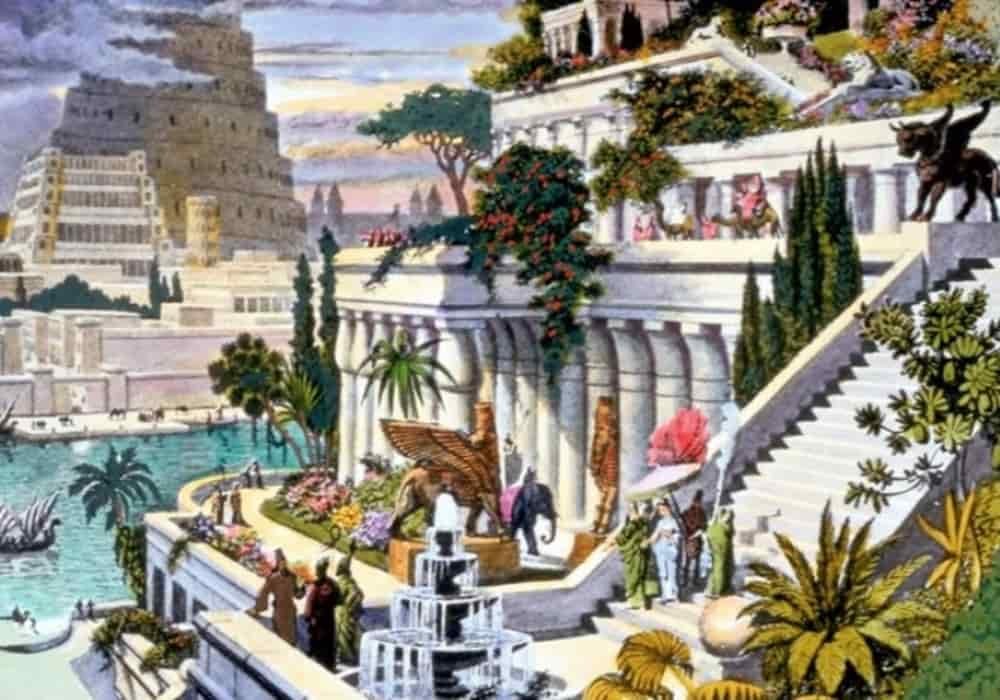Hanging Gardens Babylon
Babylon is famous for having been one of the most beautiful ancient cities ever built. Located in the middle of the desert, it once had impressive walls and notably housed hanging gardens Babylon which are among the wonders of the world. Research by a German archaeologist at the beginning of the 20th century places them in the south of the city. Another theory would place them in the Assyrian city of Nineveh, conquered by the Babylonians with the alliance of the Medes. King Nebuchadnezzar II, great military leader behind the expansion of the Empire, married Princess Mede, Amytis. According to legend, he had the gardens built to cheer him up in his homesickness and loneliness.
Location
The Hanging Gardens of Babylon is located on the eastern bank of the Euphrates, about 50 km south of present-day Baghdad, Iraq.
History of Hanging Gardends Babylon
They appear in the writings of several ancient Greek and Roman authors (Diodorus of Sicily, Strabo, Philo of Alexandria, etc.), all of whom draw inspiration from older, extinct sources, including the Babylonian priest Berosus. It is to the latter that we owe the history of the construction of these gardens by Nebuchadnezzar II in order to remind his wife, Amytis of Media, of the wooded mountains of his native country, around Ecbatane.
Babylonian royalty flourished under the reign of the famous King Hammurabi (1792-1750 BC) But it was not until the reign of King Naboplashar (625-605 BC) that this civilization Mesopotamian reaches all its glory.
It is to his son, Nebuchadnezzar II (604-562 BC) that credit is given for having built the legendary Hanging Gardens. It is said that he had them built to please his wife or concubine.
One of the Seven Wonders of the World
Despite the fact that a large number of descriptions of the Gardens come from Greek historians, the Babylonian records remain silent on this point.
The tablets of Nebuchadnezzar’s time make no reference to the Hanging Gardens, despite the descriptions found of his palace and the city
However, in the twentieth century we found some mysterious foundations that could belong to the Gardens. But archaeologists are trying to find more evidence before drawing conclusions as to the precise location of the Hanging Gardens, its irrigation system and its actual appearance.
Description
The detailed descriptions come from Greek sources, such as those of the writings of Strabo or of Philo of Byzantium which can be read below:
The Gardens were built in the shape of a pyramid, each staircase forming a terrace. The flowers and trees that grew there hid the foundations of the site, which made it look like the Gardens were floating in the air without any support, hence its name of Hanging Gardens.
The elevation of the gardens would be done with several terraces, perhaps in steps. Diodorus describes a complex process associating several layers of stone, reed, bitumen and lead developed to prevent the moisture of the earth constituting the top layer of soil in gardens from spreading below. His description of the galleries supporting the gardens is less clear, however.
Another interesting point in the stories is the channeling of water to the high gardens. Philo, the most interested in the technical aspects of the building, describes at length the system of canals used to irrigate the park. Strabo remains the only one to clearly describe the means by which the water is raised, namely an Archimedean screw, operated by humans, which seems to be found in the evocation of a system of conduits and spirals in Philo. According to Strabo and Diodorus, the water comes from the Euphrates. This would serve to support lush gardens, where large trees of a wide variety of species are planted.
Despite more realistic descriptions, it is the magical image of Philo in his work De septem orbis spectacularulis which remains anchored in memories: “The garden that we call suspended, because it is planted above the ground, is grown in the air; and the roots of the trees make like a roof, high above, above the earth”.
Egypt Dynasty | Timeline, List of Egyptian Ancient dynasties and Pharaohs
Photo source: Wikimedia Commons
Photo explainations: Hanging Gardens of Babylon. 19th century illustration.
Hanging Gardens of Babylon’ probably 19th century after the first excavations in the Assyrian capitals. :The Hanging Gardens Babylon – This hand-coloured engraving probably made in 19th century after the first excavations in the Assyrian capitals, depicts the fabled Hanging Gardens of Babylon, one of the Seven Wonders of the World.
According to the tradition, the gardens did not hang, but grew on the roofs and terraces of the royal palace in Babylon. Nebuchadnezzar II, the Chaldean king, is supposed to have had the gardens built in about 600 BC as a consolation to his Median wife, who missed the natural surroundings of her homeland.



